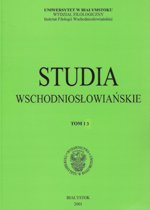Wizerunki władczyń moskiewskich XVI i XVII w. w bylinach i folklorze rosyjskim
Images of Russian Grand Princesses and Tsarinas of the Sixteenth and Seventeenth Centuries in Russian Bylinas and Folklore
Author(s): Zofia A. BrzozowskaSubject(s): Customs / Folklore, Studies of Literature, Russian Literature, 16th Century, 17th Century, Philology
Published by: Wydawnictwo Uniwersytetu w Białymstoku
Keywords: Russian folklore; Bylinas; Muscovy rulers;
Summary/Abstract: The main purpose of this paper is to present images of “shadow” wives of Russian rulers in bylinas (epic poetry) and the other artifacts of the East Slavic folklore. Main heroines of hereby article are: – Solomonia Saburova, which was the first wife of Vasilii III, grand prince of Muscovy. When after twenty years of marriage Solomonia remained childless, her husband decided to divorce the grand princess and forcibly confine her in a convent. – Anastasia Romanovna – the daughter of the boyar Roman Zakharin, who gave his name to the later Romanov dynasty. Both official and folkloristic sources describe her as “virtuous and courteous” tsarina, despite the fact, that she took no interest in governmental affairs and had relatively little political influence on her husband. – Maria Temryukovna – the daughter of prince Temrjuk of Kabardia. She became wife of tzar Ivan the Terrible after the death of Anastasia. Artifacts of the Russian folklore (epic poetry) tell, how Romanovna, before death, warned Ivan not to take a pagan wife. – Marina Mniszech – Polish noblewoman, who became wife of False Dmitri I. In East Slavic folklore she is definitely negative figure. Bylinas describe her as a heretic and adulteress – “Marinka the witch”.
Journal: Studia Wschodniosłowiańskie
- Issue Year: 2012
- Issue No: 12
- Page Range: 41-56
- Page Count: 16
- Language: Polish

